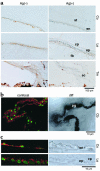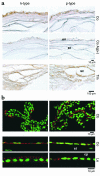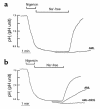Molecular basis of ocular abnormalities associated with proximal renal tubular acidosis
- PMID: 11435462
- PMCID: PMC209339
- DOI: 10.1172/JCI11869
Molecular basis of ocular abnormalities associated with proximal renal tubular acidosis
Abstract
Proximal renal tubular acidosis associated with ocular abnormalities such as band keratopathy, glaucoma, and cataracts is caused by mutations in the Na(+)-HCO(3)(-) cotransporter (NBC-1). However, the mechanism by which NBC-1 inactivation leads to such ocular abnormalities remains to be elucidated. By immunological analysis of human and rat eyes, we demonstrate that both kidney type (kNBC-1) and pancreatic type (pNBC-1) transporters are present in the corneal endothelium, trabecular meshwork, ciliary epithelium, and lens epithelium. In the human lens epithelial (HLE) cells, RT-PCR detected mRNAs of both kNBC-1 and pNBC-1. Although a Na(+)-HCO(3)-cotransport activity has not been detected in mammalian lens epithelia, cell pH (pH(i)) measurements revealed the presence of Cl(-)-independent, electrogenic Na(+)-HCO(3)-cotransport activity in HLE cells. In addition, up to 80% of amiloride-insensitive pH(i) recovery from acid load in the presence of HCO(3)(-)/CO(2) was inhibited by adenovirus-mediated transfer of a specific hammerhead ribozyme against NBC-1, consistent with a major role of NBC-1 in overall HCO(3)-transport by the lens epithelium. These results indicate that the normal transport activity of NBC-1 is indispensable not only for the maintenance of corneal and lenticular transparency but also for the regulation of aqueous humor outflow.
Figures








Similar articles
-
Localization of Na+-HCO-3 cotransporter (NBC-1) variants in rat and human pancreas.Am J Physiol Cell Physiol. 2003 Mar;284(3):C729-37. doi: 10.1152/ajpcell.00166.2002. Epub 2002 Nov 20. Am J Physiol Cell Physiol. 2003. PMID: 12444017
-
Molecular and functional evidence for electrogenic and electroneutral Na(+)-HCO(3)(-) cotransporters in murine duodenum.Am J Physiol Gastrointest Liver Physiol. 2001 Mar;280(3):G332-43. doi: 10.1152/ajpgi.2001.280.3.G332. Am J Physiol Gastrointest Liver Physiol. 2001. PMID: 11171615
-
Intracellular pH regulatory mechanism in a human renal proximal cell line (HKC-8): evidence for Na+/H+ exchanger, CI-/HCO3- exchanger and Na+-HCO3- cotransporter.Pflugers Arch. 2000 Sep;440(5):713-20. doi: 10.1007/s004240000356. Pflugers Arch. 2000. PMID: 11007312
-
The sodium bicarbonate cotransporter: structure, function, and regulation.Semin Nephrol. 2006 Sep;26(5):352-60. doi: 10.1016/j.semnephrol.2006.07.008. Semin Nephrol. 2006. PMID: 17071329 Review.
-
Functional and molecular properties of Na+:HCO-3 cotransporters (NBC).Minerva Urol Nefrol. 2003 Jun;55(2):131-40. Minerva Urol Nefrol. 2003. PMID: 12847417 Review.
Cited by
-
The effect of topical amiloride eye drops on tear quantity in rabbits.Mol Vis. 2010 Nov 4;16:2279-85. Mol Vis. 2010. PMID: 21139975 Free PMC article.
-
Functional Roles of Electrogenic Sodium Bicarbonate Cotransporter NBCe1 in Ocular Tissues.Open Ophthalmol J. 2012;6:36-41. doi: 10.2174/1874364101206010036. Epub 2012 Jun 21. Open Ophthalmol J. 2012. PMID: 22798968 Free PMC article.
-
Functional analysis of a novel missense NBC1 mutation and of other mutations causing proximal renal tubular acidosis.Pflugers Arch. 2008 Jan;455(4):583-93. doi: 10.1007/s00424-007-0319-y. Epub 2007 Jul 28. Pflugers Arch. 2008. PMID: 17661077
-
Mutational and functional analysis of SLC4A4 in a patient with proximal renal tubular acidosis.Pflugers Arch. 2004 Jul;448(4):438-44. doi: 10.1007/s00424-004-1278-1. Epub 2004 Apr 14. Pflugers Arch. 2004. PMID: 15085340
-
Role of NBC1 in apical and basolateral HCO3- permeabilities and transendothelial HCO3- fluxes in bovine corneal endothelium.Am J Physiol Cell Physiol. 2005 Mar;288(3):C739-46. doi: 10.1152/ajpcell.00405.2004. Epub 2004 Nov 17. Am J Physiol Cell Physiol. 2005. PMID: 15548570 Free PMC article.
References
-
- Winsnes A, Monn E, Stokke O, Feyling T. Congenital persistent proximal type renal tubular acidosis in two brothers. Acta Paediatr Scand. 1979;68:861–868. - PubMed
-
- Braverman DE, Snyder WE. A case report and review of band keratopathy. Metab Pediatr Syst Ophthalmol. 1987;70:39–41. - PubMed
-
- Igarashi T, et al. Mutations in SLC4A4 cause permanent isolated proximal renal tubular acidosis with ocular abnormalities. Nat Genet. 1999;23:264–266. - PubMed
-
- Romero MF, Hediger MF, Boulpaep EL, Boron WF. Expression cloning and characterization of a renal electrogenic Na+/HCO3- cotransporter. Nature. 1997;387:409–413. - PubMed

